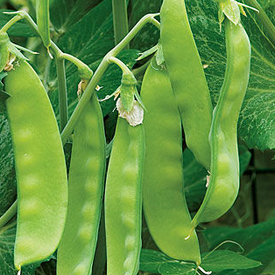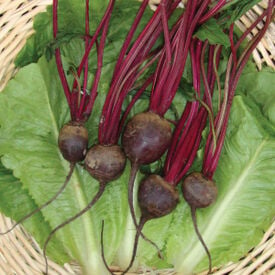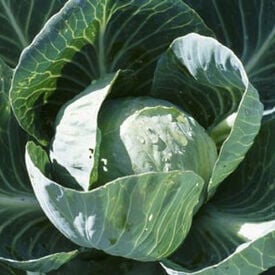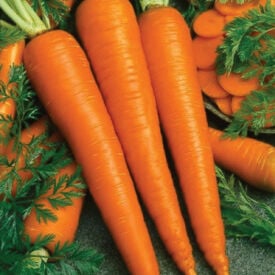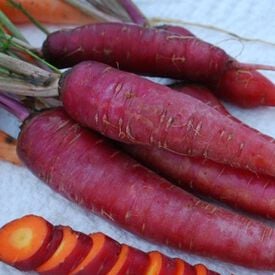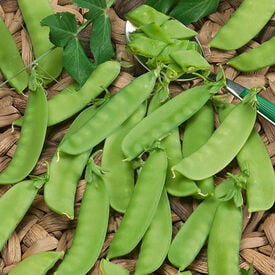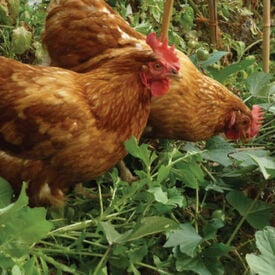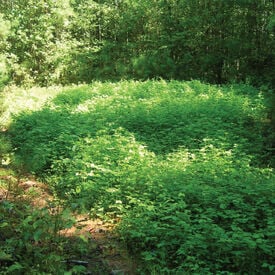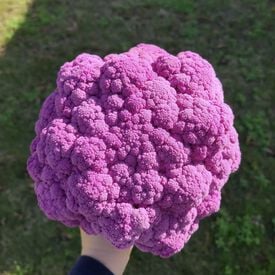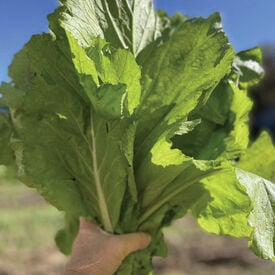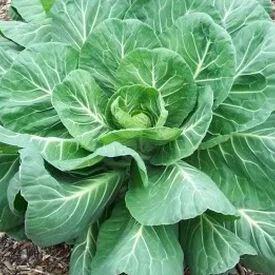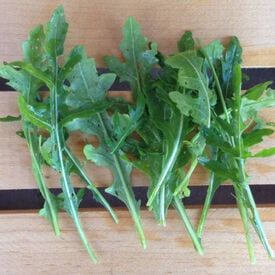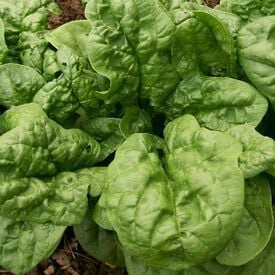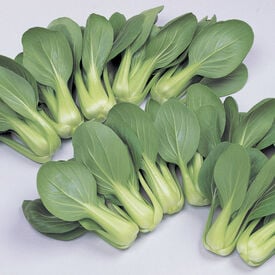The Oregon Sugar Pod II Pea is a high yielding snow pea that has a high percentage of two pods per cluster! This variety grows to a height of 28" and bears 4 1/2" long pods that are disease resistant to pea virus, common wilt and powdery mildew. The Oregon Sugar Pod II produces delicious flat and tender pea pods that are superb for freezing!
The Detroit Dark Red is the standard all-purpose heirloom beet! This is by far the most popular beet for home gardens. Detroit Dark Red has blood red flesh that is very sweet and tasty. Beets are perfectly round with no rings or streaks. Has 13-16" greens that are wonderful mixed into salads. Very prolific and good keeper. This heirloom was first introduced in 1892 by Mr. Reeves of Ontario, Canada.
The All Seasons Cabbage is a very heat resistant cabbage that is resistant to yellowing and will offer a nice flavor in any dish. This cabbage produces fine heads that are about 10-11" across and average about 11-14 pounds.
The Imperator 58 is a Danver carrot that is a garden staple! This carrot variety grows to 9" long and 1 1/2" wide. It has a very sweet and tender flavor. This carrot has smooth, large, fine-grained, long, tapered roots. Imperator 58 carrot performs best in loose, friable soils.
The Dragon carrot is a refined purple carrot that is perfect for home gardeners and market growers! The reddish purple color on the outside contrasts with the bright orange interior when peeled or sliced. The Dragon has a delicious sweet, slightly spicy, carrot flavor that is delicious roasted or in soups and stews.
The Mammoth Melting Pea is a snow pea that adds the perfect mouthwatering crunch to any salad! The 5-6 foot tall vines require trellising for support. This variety's large sweet pods thrive in the cooler weather. Add a fresh pop of bright green to any garden or dish with the Mammoth Melting! Certified Organic. Learn more about our organic seeds.
Growing your own forage for your chickens is a cheap, easy, and a highly nutritious way to feed your chickens. Chicken feed can be expensive to provide throughout the year. Growing your own from spring to fall provides high levels of nutrients that will make your eggs taste even better. Foraging chickens have a better balanced diet that creates better eggs and meat. This chicken forage blend is a mix of well balanced plants that chickens love to eat. Spread at 5 lbs. per 1,000-2,000 square feet. 100 lbs will cover 1 acre. Mixture includes: Annual Ryegrass, Perennial Ryegrass, Buckwheat, Flax, Millet, Forage Peas, Red Clover, Alfalfa
All of the seeds below are very good at attracting deer to your property! Buckwheat - Improves top soil and an effective choke weed! Plant late spring to early summer. Establishes quickly. Matures in 60 days. Accumulates phosphorus and and potassium for following crops. Frost sensitive. All below packages come in 1lb. bags. Crimson Clover - Winter annual protects and improves soil! Plant fall or early spring. A good nitrogen fixer (70-150 lbs per acre per year). Showy crimson blooms in late spring are an excellent source of nectar for bees. Inter-seeds well with grass. Austrian Winter Pea - A great cool season legume for cover crops, wildlife and winter grazing! Austrian winter pea, sometimes called "black pea" and "field pea" is a cool-season, annual legume with good, nitrogen-fixing capabilities. Austrian winter pea is a low-growing, viny legume which has been shown to fix over 200 pounds of nitrogen per acre per year. Peas - Grow regular old peas in your deer food plot. One of the most preferred vegetables for deer. Oats - Oats will kill off winter weeds and hold soil with a mat of vegetation! A high yielding oat that can produce over 100 bushels per acre. Plant anytime of the year. Deer will graze oats all year round. Barkant Forage Turnip - Great forage crop that provides high energy feed! Barkant turnips are an improved, early maturing, diploid turnip wtih a large purple tankard shaped bulb. Barkant turnips have a high leaf to stem ratio and and provide very high contentrations of protein, sugar content and leaf yields. Barkant Turnips are ideally suited for wildlife. Dwarf Essex Rape - A cabbage related plant that is a perfect grazer! Dwarf Essex Rape is a perfect grazer plant that will persist well after the first frost. Ready to pasture 6-8 weeks after sowing. Hairy Vetch - Sow with or without grain, grass or field peas! When sown late summer, grows fast and will attract wildlife. Hairy Vetch has rapid growth that makes it a good weed suppressant.
The Graffiti cauliflower has a fun purple head with a great flavor! Graffiti produces a true deep purple head. This variety is a large cauliflower plant with dark green leaves and it produces best in the fall. It can also be planted in early spring. The Graffiti is very fun to watch grow and eat!
Florida Broadleaf mustard is a classic Southern heirloom variety long valued for its fast growth, large yields, and reliable performance in warm climates. Originating in the southeastern United States, it produces broad, bright green, smooth-edged leaves that can grow 10–12 inches long, forming an upright, leafy plant about 18–24 inches tall. The leaves are tender yet substantial, with a bold, peppery flavor that mellows pleasantly when cooked. This mustard variety thrives in full sun and prefers rich, well-drained soil with consistent moisture. It grows best in cool to mild temperatures, typically between 50–75°F, making it ideal for spring and fall gardens, though it can tolerate light frosts and brief periods of heat.
Georgia Southern is a large collard plant with a cabbage-like taste! This variety produces bluish-green leaves that can grow up to 36" tall and do not bunch or head like cabbage leaves. These large open heads are great for cooking or freezing. The Georgia Southern collard is vitamin rich, sweet, not bitter, heat tolerant, and frost hardy.
A slow growing arugula with great tasting peppery leaves! This variety produces 4" deeply cut leaves that have a slightly sharp pepper flavor. The Sylvetta is compact, heat and cold tolerant. If you are looking to spice up your salads and meals, then this is for you!
The Bloomsdale spinach is such an attractive, tasty, and a popular garden standard spinach. This variety is an old favorite amongst gardeners. It has an excellent flavor and produces large quantities of tasty leaves. Bloomsdale is also very nutritious with lots of Vitamin A, C, and iron and is low in calories.
Li Ren Choi cabbage is good looking mini pak choi with light green stems and slightly darker green leaves. This variety develops a pak choi shape at a very early stage. It can even be planted in trays and harvested at transplanting time. It is one of the smaller mini pak choies on the market. Excellent production for pak choi hearts.
Tendergreen Spinach (Komatsuna) mustard is a prized leafy green known for its mild flavor and tender texture, making it a favorite in both culinary and gardening circles. This variety of mustard greens has its roots in traditional Southern U.S. agriculture, where it has been cultivated for its versatility and ease of growth. Characterized by its large, bright green leaves with a smooth, slightly wrinkled texture, Tendergreen mustard is valued for its mild, peppery flavor that becomes more pronounced when cooked. The plants grow rapidly, reaching maturity in about 40 to 50 days, and are known for their robust, upright growth habit, typically standing 12 to 18 inches tall. They produce small, yellow flowers in early spring if allowed to bolt, though they are primarily grown for their leaves. Tendergreen mustard thrives in cool weather and can be grown in a variety of soil types as long as they are well-drained. The plant’s resilience and quick harvest make it ideal for successive plantings, providing a continuous supply of fresh greens. With its rich flavor, adaptable growing conditions, and rapid growth, Tendergreen mustard is a valuable addition to any vegetable garden.
The Lutz Green Leaf White Stem Beet is an attractive deep red variety with white stalks that is absolutely delicious when steamed or roasted. This beet is known for having huge glossy, deep green tops that are perfect for salads! This beet is a "winterkeeper" beet that has a long standing storage capability. The Lutz Green Leaf White Stem has 6 inches in diameter roots.
Ruby Red Swiss Chard is a beautifully deep red colored chard. This variety is great for people who want to grow controlled colors of different Swiss Chard. The Ruby Red is fast growing, very tasty and will add a pop of color to any garden!
The Sugar Snap Pea is a garden staple pea that has unmatchable taste! This variety has tall vines that with support can grow up to 6 feet plus! The Sugar Snap Pea plant produces 3" long pods that are a 1/2" across, and bear over a long picking period. This is pea is so tasty that people will eat it directly after picking! Sugar Snap yields well in both hot and cold weather.
